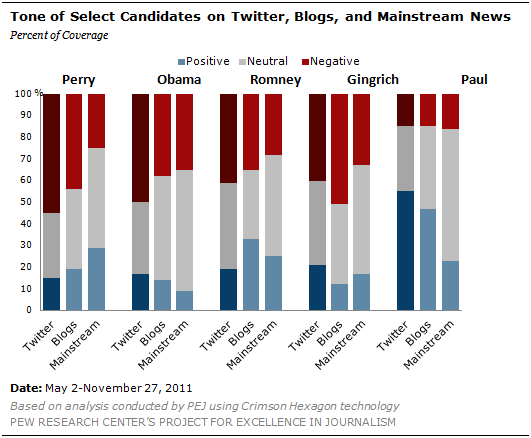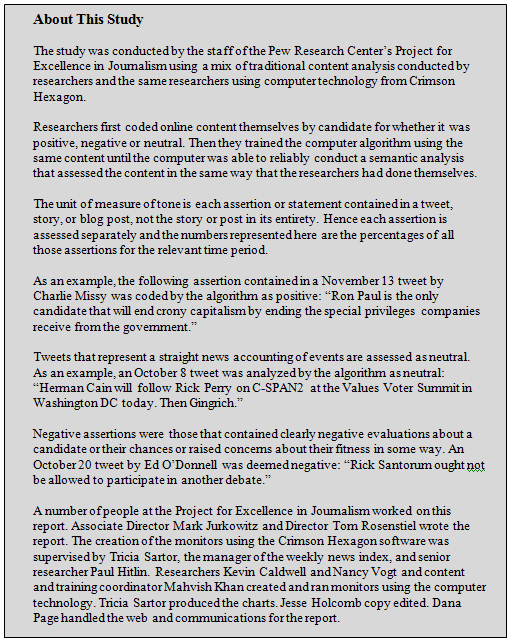How the Discussion on Twitter Varies from Blogs and News Coverage And Ron Paul’s Twitter Triumph
A detailed examination of more than 20 million Tweets about the race for president finds that the political discussion on Twitter is measurably different than the one found in the blogosphere-more voluminous, more fluid and even less neutral.
But both forms of social media differ markedly from the political narrative that Americans receive from news coverage, according to a new study by the Pew Research Center’s Project for Excellence in Journalism, which examines campaign coverage and the online conversation from May 2-November 27.

One distinguishing factor about the campaign discourse on Twitter is that it is more intensely opinionated, and less neutral, than in both blogs and news. Tweets contain a smaller percentage of statements about candidates that are simply factual in nature without reflecting positively or negatively on a candidate.
In general, that means the discourse on Twitter about the candidates has also been more negative.
The political discussion on Twitter has also fluctuated with events more than it has in the blogosphere, where the authors seem to have made up their minds and where the tone about candidates shifts relatively little. On Twitter, the conversation about a candidate sometimes changed markedly from week to week, shifting from positive to negative and vice versa.
Finally the new study found that the candidate conversation on Twitter is tremendously active-indeed the number of statements about candidates on Twitter vastly outnumber those offered in blogs by a factor of more than 9 to 1.
While it is impossible to know whether the blog sample is capturing the entirety of the political blog conversation, as it is captured on Twitter, it does include all the blogs that enjoy broad traffic and that are tracked by the major blog monitoring services. Data from the Pew Internet & American Life Project shows that a slightly higher percentage of adult internet users say they blog (14%) than use Twitter (13%). And according to the survey, Twitter use is slightly bigger among male internet users than females, most popular among those 18-29 and more widely used by non-white internet users than white ones.
If the difference in volume between Twitter and blogs is indicative of something about the volume of the discourse in those two universes, it suggests that tweeting-with its trim 140-character format that readily invites the instantaneous observation-is a more frequent activity than blogging.
The Twitter sample for this study is derived from “the Twitter Firehose data feed,” which includes all public tweets from the Twitter system, some 140 million posted every day. From that large universe, the analysis examined those tweets that directly addressed the 2012 presidential campaign. (For blogs, the universe is broad, hundreds of thousands of blogs each day, as tracked by the company Crimson Hexagon.)
And in that campaign discussion on Twitter, one candidate has fared better than anyone else. Congressman Ron Paul has enjoyed the most favorable tone on Twitter of all candidates examined. From May through November, fully 55% of the assertions about the Texas Republican on Twitter have been positive-the highest of any candidate-while 15% have been negative-the lowest percentage of any candidate. That is a differential for Paul of 40 points on the positive side.
Paul is also the most favorably discussed candidate in blogs. While he trails significantly in the polls, and has received less coverage than every Republican candidate except Rick Santorum from news outlets, Paul seems to have struck a chord with some cohort in social media.
This treatment of Paul stands in contrast to that of most of the GOP field, for whom Twitter has been a tough neighborhood. Five of Paul’s seven GOP rivals have had negative opinions on Twitter outstrip positive ones by roughly 2-1 or more.
One exception was businessman Herman Cain-about whom Twitter had been up and then down before he suspended his campaign on December 3 in the wake of allegations of sexual harassment and of a long-term affair. Former Utah Governor Jon Huntsman received more positive than negative assertions though the volume of conversation about him is small.
On the other side of the political spectrum, President Obama’s negative evaluations on Twitter outweighed his positive ones by 3-1. But overall on Twitter, as is true in blogs, other candidates have received rougher treatment than the president. Obama’s most sharply negative assessment has come from the news media, not social media.
These are some of the findings of the study, which also updates the tone and amount of narrative of each candidate in news coverage overall, in a sub-sample of national news outlets, and in the political blogosphere.
The work is part of a new ongoing analysis of the race for president conducted by PEJ that will continue through the election, tracking the amount of attention paid to the candidates in different media platforms and the tone of that attention. The research combines PEJ’s traditional ongoing weekly content analysis conducted by human researchers with computer algorithmic technology developed by the company Crimson Hexagon.
This report, which tracks from May 2 through November 27, captures in close to entirety the first phase of the 2012 campaign, that period before voters are formally involved, the time that might be called The Media Primary. Among its findings is that Twitter and blogs differ enough that the concept of social media as a single form of communication is probably an oversimplification.
The findings also suggest that neither Twitter nor blogs function in general as a form of vox populi that either reflects or anticipates changes in public mood as expressed in representative samples of the population in polling. Sometimes these social media move with polls, but often they do not.
When it comes to news coverage, this research of tone is not a study of media fairness or bias. Rather, it offers a comprehensive, quantitative analysis of whether the messages Americans receive about a candidate in the news media are positive, negative or neutral. The work examines and quantifies all the assertions about a candidate in news stories, editorial and commentaries, whether they come from journalists, supporters, opponents, citizens, newsmakers, pundits, polling data or other sources. The goal is to understand the overall narrative about that candidate. When a candidate is widely criticized by rivals, for instance, Americans are hearing negative statements. When a candidate begins to surge in the polls, and his or her candidacy begins to look more viable, Americans are receiving positive statements about that candidate. In blogs and Tweets, similarly, all assertions are examined.
Among the study findings:
- While they differ, Twitter and blogs both produced harsher narratives overall about the candidates than did news coverage. On Twitter, negative assertions outstripped positive ones for six of the eight GOP candidates, and in five of those cases, by a wide margin. The same was true in blogs. In the news media, only one GOP candidate had a clearly negative narrative, and for four GOP hopefuls, the narrative was more positive than negative.
- Since October, there have been some notable shifts in the tone of the Twitter conversation for several GOP hopefuls. Three of them-Mitt Romney, Herman Cain and Rick Perry-experienced their most negative assessments on Twitter in the past eight weeks. And one candidate, Newt Gingrich, enjoyed his first week of more positive than negative assessments starting October 24.
- In news coverage, the most covered candidate in the last seven weeks was Herman Cain, and that heavy attention was not favorable. Before he suspended his campaign, Cain suffered six straight weeks in which negative assertions in the news outnumbered positive ones-a period of scrutiny that began before allegations about sexual misconduct surfaced and came after nine weeks of positive coverage from August through mid-October. Thus Cain’s candidacy involved three distinct periods in news coverage- limited attention for two and a half months, a period of rising coverage for three months, and six weeks of intensifying and ultimately decisive scrutiny.
- While he has enjoyed the biggest surge in polling numbers in the last month, former House Speaker Newt Gingrich has experienced only a minimal improvement in the tone of his news coverage. It has gone from very heavily negative to only modestly so. For the full seven months studied, Gingrich has had the most unflattering narrative in news coverage of any GOP contender-17% positive, 33% negative and 50% neutral.
- In the blogosphere, since May only one candidate other than Ron Paul-Cain-has received more positive than negative coverage, and that by the razor thin margin (32% positive and 30% negative). The most discussed GOP contender in the blogosphere has been Romney, but the tone has been mixed, with 33% of the conversation positive and 35% negative. Yet that is a much better result than Romney has had in Twitter.
